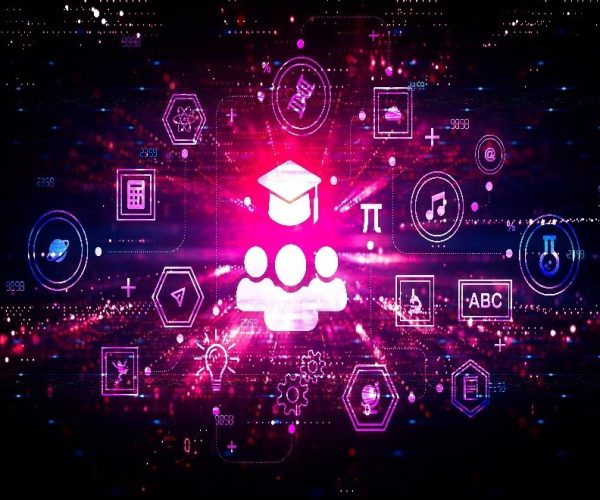What is artificial intelligence (AI)?
Artificial Intelligence (AI) is revolutionizing the way we live and get things done. AI is the simulation of human intelligence processes by machines. As the hype around AI has accelerated, software development vendors have been scrambling to promote how their products and services use it. Often, what they refer to as AI is simply a component of the technology, such as machine learning. AI requires a foundation of specialized hardware and software for writing and training machine learning algorithms. No single programming language is synonymous with AI, but Python, R, Java, C++, and Julia have features popular with AI developers.
In general, AI systems work by ingesting large amounts of labeled training data, analyzing the data for correlations and patterns, and using these patterns to make predictions about future states. In this way, a chatbot that is fed examples of text can learn to generate lifelike exchanges with people, or an image recognition tool can learn to identify and describe objects in images by reviewing millions of examples. New, rapidly improving generative AI techniques can create realistic text, images, music and other media.
AI programming focuses on cognitive skills that include the following:
- This aspect of AI programming focuses on acquiring data and creating rules for how to turn it into actionable information. The rules, which are called algorithms, provide computing devices with step-by-step instructions for how to complete a specific task.
- This aspect of AI programming focuses on choosing the right algorithm to reach a desired outcome.
- Self-correction.This aspect of AI programming is designed to continually fine-tune algorithms and ensure they provide the most accurate results possible.
- This aspect of AI uses neural networks, rules-based systems, statistical methods, and other AI techniques to generate new images, new text, new music and new ideas.
There are thousands of AI applications across multitude of sectors of which below are some of the examples:
1. AI Applications in Social Media
In this digital era, AI has become the basic element of all the well-known social networks we are using on a routine basis. Let’s explore some of the AI solutions used in social media.
1.1 Facebook

X (formerly Twitter)
X is the fastest-growing social platform. Using AI, it analyzes the complete image and identifies a face from it for thumbnail creation to decode the part of an image that would be most liked by the user. AI also analyzes the whole content of a post and suggests the most relevant tweet for that post.
1.3 Instagram
Instagram leverages AI to identify visuals or images. It selects the content from social media and automatically generates descriptions.
1.4 LinkedIn
LinkedIn is employing AI to offer job recommendations, serve you with the most relevant posts in your feed and suggest to you the persons with whom you must connect.
1.5 Pinterest
Pinterest connects the images with Artificial Neural Networks to display that content to the users in which they are most interested. Pinterest users have saved above 240 billion pins within eleven years of its business, with 533 pins per user on average. About 80% of these users are recorded to buy the personalized content that has just been possible with AI.
How It’s Done
AI is helping individuals and entrepreneurs to automate mundane tasks and monitor social media activities at scale by using the following algorithmic methods:
- Auto generating post content
- Spam detection and filtration
- Sentiment analysis and auto-response
- Optimizing social media channels
- Managing advertisements with predictive technology
1.6 ChatGPT
ChatGPT is a computer program that can understand human language and generate its own text in response to it. Think of it like a really smart robot that you can talk to, and it will talk back to you. ChatGPT is trained on huge amount of text data from books, articles, and websites, so ChatGPT has learned a lot about how people use language.
When you give ChatGPT some text to work with, it uses what it’s learned from that massive dataset to try and predict what text should come next. It does this by breaking down the input text into smaller parts and using complex math to figure out what the most likely next part should be. Then, once ChatGPT has predicted what the next part of the text should be, it generates that text and uses it to keep predicting what comes next. This process continues until ChatGPT has generated a whole response to your original text.
Practical Use Cases of ChatGPT
- Generate text
- Solve math problems
- Write code
- Translate languages
- Write a resume
- Smart assistant
2. Artificial Intelligence in Business
Artificial intelligence (AI) has a wide range of applications in business across various industries. These applications can improve efficiency, decision-making, customer experiences, and more. Here are some key AI applications in business:
2.1 Customer Service and Support:

2.2 Data Analytics and Insights:
- Predictive Analytics: AI algorithms can analyze historical data to make predictions about future trends and customer behavior, aiding in inventory management and demand forecasting.
- Data Visualization: AI can help create interactive dashboards and visualizations for better data-driven decision-making.
2.3 Marketing and Sales:
- Personalization: AI can analyze customer data to offer personalized product recommendations, content, and marketing campaigns.
- Lead Scoring: AI can identify potential high-value leads by analyzing customer behavior and engagement data.
2.4 Supply Chain Management:
- Inventory Optimization: AI can optimize inventory levels, reducing carrying costs and stockouts.
- Route Optimization: AI can help optimize delivery routes, reducing transportation costs and improving delivery times.
- Risk Assessment: AI can assess credit risk by analyzing borrower data and transaction history.
- Algorithmic Trading: AI algorithms can analyze market data and execute trades at high speeds to capitalize on market opportunities.
2.5 Manufacturing and Operations:
- Predictive Maintenance: AI can predict when machinery and equipment are likely to fail, allowing for proactive maintenance.
- Quality Control: AI can identify defects in real-time on the production line, reducing waste and improving product quality.
2.6 Energy and Utilities:
- Energy Management: AI can optimize energy consumption in buildings and industrial processes.
- Grid Management: AI can help manage and optimize power distribution in smart grids.
2.7 Legal Services:
- Document Review: AI-powered tools can review legal documents and contracts for relevant information and anomalies.
2.8 Security:
- Anomaly Detection: AI can identify unusual patterns in network traffic or user behavior to detect cybersecurity threats.
3. Artificial Intelligence in Education
Artificial intelligence (AI) has the potential to significantly impact education by enhancing various aspects of teaching, learning, and administrative processes. Here are some key AI applications in education:
3.1 Personalized Learning:
- Adaptive Learning Platforms: AI-driven systems can adapt learning materials and activities to individual student’s abilities and learning styles, providing a customized learning experience.
- Recommendation Systems: AI algorithms can recommend relevant educational resources, such as textbooks, videos, or exercises, based on a student’s progress and preferences.

3.2 Assessment and Grading:
- Automated Grading: AI can automate the grading of assignments and tests, providing quick feedback to students and saving teachers’ time.
- Plagiarism Detection: AI tools can identify instances of plagiarism in student submissions.
3.3 Tutoring and Support:
- Intelligent Tutoring Systems: AI-powered tutors can assist students in real-time, providing explanations and additional practice when needed.
- Virtual Teaching Assistants: AI chatbots can answer common student queries and offer guidance on course materials.
3.4 Language Learning:
- Language Translation and Pronunciation: AI language models can assist in language translation, pronunciation correction, and language practice.
- Language Learning Apps: AI-driven language learning apps can adapt content and exercises based on the learner’s proficiency level.
3.5 Early Intervention:
- Identifying At-Risk Students: AI can analyze student data to identify those at risk of falling behind or dropping out, enabling early intervention by educators.
3.6 Administrative Efficiency:
- Student Enrollment and Scheduling: AI can streamline administrative tasks, such as student enrollment and class scheduling.
- Resource Allocation: AI can help optimize resource allocation, such as classroom utilization and budget management.
3.7 Content Creation:
- Content Generation: AI can assist teachers in creating educational content, including quizzes, lesson plans, and learning materials.
- Automated Transcription and Captioning: AI can transcribe and provide captions for video and audio content, improving accessibility.
3.8 Parent and Teacher Communication:
- Communication Platforms: AI-powered communication platforms can facilitate communication between parents, teachers, and students, sharing updates on academic progress and school events.
3.9 Quality Control and Curriculum Improvement:
- Data Analytics: AI can analyze data on student performance to identify trends and areas where curriculum improvements are needed.
AI applications in education have the potential to make learning more effective, accessible, and efficient. However, it’s important to implement these technologies thoughtfully and ethically to ensure that they enhance the educational experience for all students.
4. Artificial Intelligence in Healthcare
AI in healthcare’s ability to analyze vast amounts of clinical documentation quickly helps medical professionals identify disease markers and trends that would otherwise be overlooked. The potential applications of AI and healthcare are broad and far-reaching, from scanning radiological images for early detection to predicting outcomes from electronic health records. By leveraging artificial intelligence in hospital settings and clinics, healthcare systems are becoming smarter, faster, and more efficient in providing care to millions of people worldwide.
4.1 Medical Imaging: Images showcasing AI’s role in medical imaging, such as X-rays, MRIs, CT scans, and ultrasounds. This might include images of AI algorithms assisting radiologists in identifying anomalies or highlighting regions of interest.

4.2 Telemedicine:
Visuals of patients and healthcare providers interacting through AI-powered telemedicine apps or platforms, including video consultations and remote monitoring.
4.3 Health Monitoring Wearables:
Pictures of individuals wearing smartwatches, fitness trackers, or other wearables that use AI to track vital signs, activity levels, and provide health insights.
4.4 Electronic Health Records (EHRs):
Images illustrating the use of AI to manage and analyze electronic health records, with healthcare professionals accessing patient data and clinical decision support systems.
4.5 Surgical Robotics:
Photos of robotic surgical systems being used by surgeons, with AI assisting in precise and minimally invasive procedures.
4.6 Drug Discovery:
Visuals of scientists and researchers using AI to discover and develop new drugs and therapies. This may include images of molecular structures and high-throughput screening.
4.7 AI Chatbots for Health Queries:
Screenshots or illustrations of AI-powered chatbots or virtual assistants that provide healthcare information, answer medical questions, or schedule appointments.
4.8 Healthcare Analytics:
Visual representations of AI-driven analytics tools that help healthcare organizations optimize operations, improve patient outcomes, and reduce costs.
4.9 Patient Engagement:
Pictures of patients using AI-driven apps to actively manage their health, set reminders for medication, and access personalized health recommendations.
4.10 AI in Drug Dispensing:
Images of automated pharmacy systems and AI-driven medication dispensing robots used in healthcare facilities.
